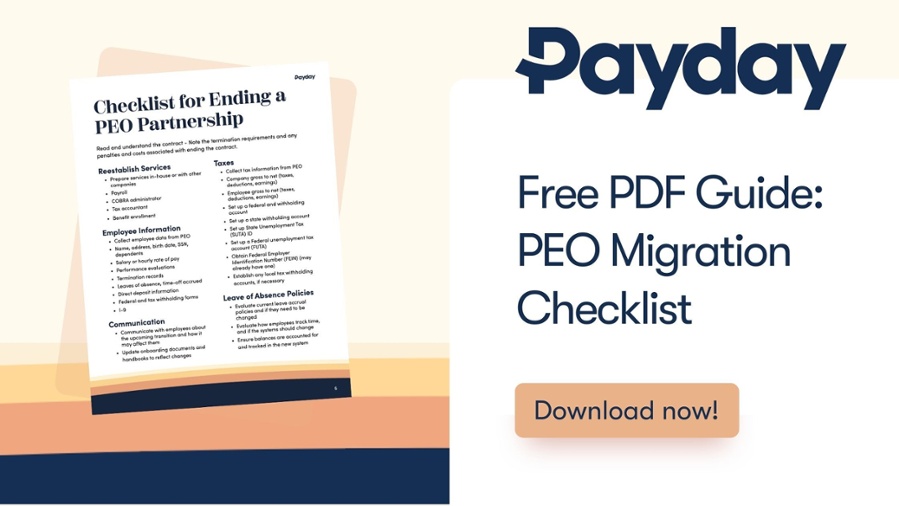Often used as a short-term solution to supply human resources or administrative support to small businesses, PEO partnerships can sometimes become unnecessary due to company-wide growth, or simply a range of negative consequences stemming from the partnership. In our recent series of articles, we’ve outlined the ways that PEOs, despite their periodic benefits, risk fracturing company culture, limiting analysis of institutional knowledge, complicating access to HR/administrative documents, slowing the hiring process, contributing to turnover, and creating other potential issues.
For a more thorough rundown of the pros and cons of hiring a PEO, please read our article on “What Are the Advantages and Disadvantages of a PEO?” For now, we’ll focus on outlining the reasons many businesses transition away from their PEO, and provide some initial suggestions for navigating that transition gracefully and with minimal financial or organizational fallout.
One common reason that businesses terminate their PEO partnership is two-fold: a) the PEO fails to adapt or tailor its services to match the growth of the business and b) the cost becomes untenable, particularly as PEOs tend to charge based on a set percentage of the company’s payroll. In other words, if you’ve hired a PEO, as your business grows, the cost of the partnership becomes significantly higher and the PEO may not be prepared to offer the degree of attentive adaptation required for you to optimize your HR and administrative practices. Often, the PEO’s inability or unwillingness to scale and move in tandem with your company’s progress leads to a souring of the partnership and a desire to transition to another strategy.
Practical Next Steps
If you’re determined to end your partnership with a non-certified PEO, consider exiting the partnership on January 1st. Otherwise, you’ll risk “double paying” for tax liabilities for your employees and the business itself. If your PEO is IRS-certified, you can safely leave the partnership at any time, since the client company (your company) is regarded as the “successor employer.” You’ll also want to create all of the following: a census file that catalogs all of your employees who receive benefits, as well as their demographic information; your past PEO invoices, employer contributions, and rates; and your PEO plan and benefit summaries, which will all help with future HR reconfigurations. More on that later.
Next, we recommend the following actions to ensure a smoother transition away from your PEO:
- Consider which in-house HR functions you’d like to create or amplify – Perhaps to compensate for inefficiencies or unsatisfactory performance from your PEO, you’ve already “put the wheels in motion” on new HR or administrative services that you’d like to offer your employees – ones that are not only specific to your industry but to your business in the present. Reflect on which services stand to grow and benefit your business as you transition away from your PEO partnership.
- Let the Accounting Begin – Although articles abound on the average ROI for PEO clients, the truth is that the numbers and yearly financial benefits vary widely based on the specific business or industry. If you’re underwhelmed with the ROI from your PEO (welcome to Acronym City) then it’s likely confirmation that you’re making the right decision. Also, remember that as your company grows, the costs of a PEO rise in tandem, even when PEOs traditionally struggle to fully adapt to the needs of businesses that have left the small- or early startup phase.
- Rally Your Staff – If you’ve looked at the numbers, gauged the negative effects of your PEO partnership, and pinpointed the ways you’d like to redefine your HR and administrative management moving forward, then it’s time to talk with your team. Not only will your employees appreciate remaining informed about forthcoming changes to their benefits and aspects of labor allocation, but they’ll also (fairly) want to hear about a thoughtful, well-informed transition strategy that will exceed the success of the PEO partnership and make HR management processes more efficient and aligned with your company culture moving ahead.
How Payday Can Help You Transition to a Streamlined Solution
A huge part of preparing for the transition away from your PEO is determining how you will reconfigure your in-house HR services after the fact. It’s wise to capitalize on opportunities to upgrade software and enlist the help of a payroll service provider who will keep you “at the helm.” If you aren’t already aware, Payday offers a number of services that are expressly designed to help growing businesses transition away from their PEO and towards autonomy, efficiency, and cohesive operations (the latter of which is often sacrificed during a PEO partnership).
First, we offer a Free PEO Migration Checklist that helps you determine which problem areas you’ll need to address during your transition, but also which opportunities are awaiting you, your employees, and your HR experts on the other side.
Additionally, our Payroll, HR, and Compliance Solutions services can provide you with more efficient (and less intrusive) versions of the services you originally sought with your PEO.
Fundamentally, we are invested in understanding your business’ needs and committed to reducing inefficiencies in payroll management, HR, and administration.
If you’re tired of a “one-size-fits-all” approach to your HR needs, contact us today to start the conversation.


